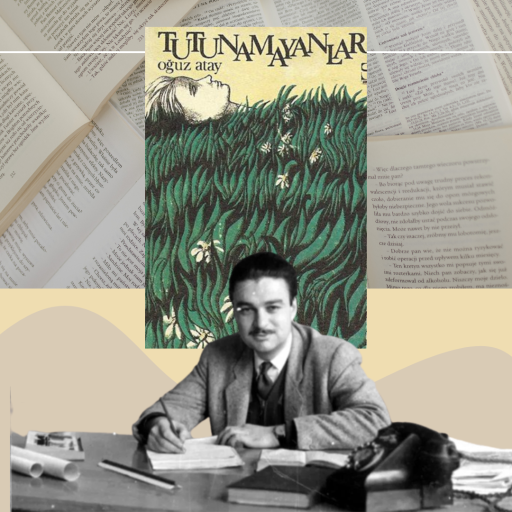Modernism in Turkish Literature: Oğuz Atay’s Tutunamayanlar
15 Ekim 2022Nazlı İrem Türkmen
The effects of modernism in Turkish literature begin with the fact that Turkey took steps towards westernization in the Tanzimat Period. The westernization seen in all areas of art has also affected literature. The literary genres that existed up to that time have undergone a significant change in content and structure, influenced by western literature. Not only the existing genres have changed, but also genres that do not exist to this day have been included in Turkish literature. Along with modernism, the traditional structure was ignored and kept up with this new emerging trend. As an example of one of the genres that have changed in terms of form and content, we can cite poetry. The new emerging genre is the novel. The first examples of the novel are not considered very qualified since it is a newly practiced genre. Still, with the passage of years, modernism in Turkish literature has developed considerably.
In literature, modernism is about the alienation, loneliness, and rebellious attitudes of the individual in terms of content. For this reason, modernist literature is also known as depression literature. The main characters who have succumbed to the modern world are described, and individuality is at the forefront. The individual’s escape from the environment of unrest created by society and his return to himself is another subject. Narrative techniques such as inner speech, inner analysis, and subconscious flow are resorted to when narrating the person’s return to himself. With the help of the stream of consciousness technique, in addition to all the thoughts and feelings of the protagonist, what lies in his subconscious is also presented to the reader in all its nakedness. This technique may cause confusion for the reader since the hero does not follow a path through his mind and jumps from topic to topic. In the internal analysis technique, the author tells about the feelings and thoughts of the protagonist. The reader transparently reads, and better understands the inner world of the protagonist with the help of all these techniques. Novels do not move along a certain timeline; that is, time jumps occur. The technique of flashback in the cinema is used. There is no obligation to have a definite beginning or end in novels. The concepts of time and space are quite in the background. Instead of a single narrator, there are multiple narrators, and time transitions occur from time to time in a way that can confuse the reader.
Oğuz Atay is one of the writers who use these narrative styles and techniques. In his article, Ertuğrul (2009) states that Oğuz Atay is the representative of the stream of consciousness technique, which was introduced to the western novel by James Joyce for the first time, in the Turkish novel. Oğuz Atay’s novel Tutunamayanlar is the most important novel in Turkish literature regarding the use of modernist techniques.
According to Apaydın (2007), Tutunamayanlar has a complex structure in terms of form and content. The reason for this complexity is the simultaneous use of many of the modernist literary techniques. Readers who were not accustomed to such novels at the time did not show much interest in the novel when it was first written. The novel was later appreciated and considered to be the most important modernist novel in Turkish literature. If we examine the novel of Tutunamayanlar in terms of form and content, the variety of the narrators seen in modernist novels is also seen in Tutunamayanlar; that is, it contains many narrators and narrative techniques. Traditionally, the dominant narrator voice in a novel is the dominant point of view that watches the events from outside and conveys the feelings and thoughts of the protagonist in every detail to the reader. In the case of Tutunamayanlar, this dominant point of view does not cover the whole of the novel, other types of narrations are also included in it. The novel’s content is also very diverse; it consists of many different genres, such as biographical writings, diary entries, letters, poems, and encyclopedic information.
To sum up, pessimistic, depressed, despairing, and alienated individuals who emerged under the influence of the First World War were also reflected in literature, and modernist literature was thus formed. In order to explain these inner struggles of individuals to the reader in a more profound and detailed way, new narrative techniques such as internal analysis and stream of consciousness have been used. The modernism movement, which emerged in the world literature at the beginning of the twentieth century, was seen for the first time in the 40s in Turkish literature, but truly modernist works began to appear in the 70s. Many names such as Orhan Pamuk, Oğuz Atay, Sait Faik Abasıyanık, Yusuf Atılgan, Bilge Karasu and Nezihe Meriç have represented modernism in Turkish literature. As mentioned above, the first work written under the modernist movement in Turkish literature was Oğuz Atay’s novel Tutunamayanlar.
References
- Apaydın, D. D. M. (2007). Oğuz Atay’ın Tutunamayanlar adlı romanında mizah ve hiciv öğeleri [Humor and satire elements in Oğuz Atay’s novel Tutunamayanlar]. Çukurova Üniversitesi Sosyal Bilimler Enstitüsü Dergisi, 16(1), 45-68.
- Ertuğrul, K. (2009). A reading of the Turkish novel: Three ways of constituting the “Turkish Modern.” International Journal of Middle East Studies, 41(4), 635-652.
- Yürek, H. (2008). Türk romanında Modernist etkinin boyutları [Dimensions of Modernist influence in Turkish novel]. Gazi Üniversitesi Gazi Eğitim Fakültesi Dergisi, 28(1), 187-202.

